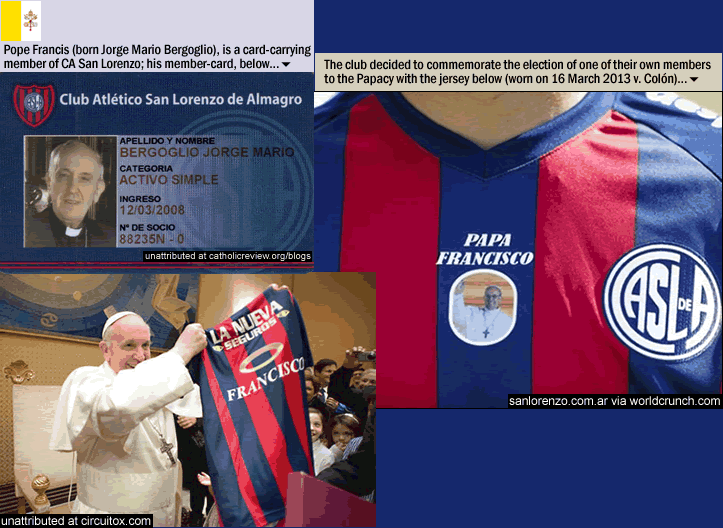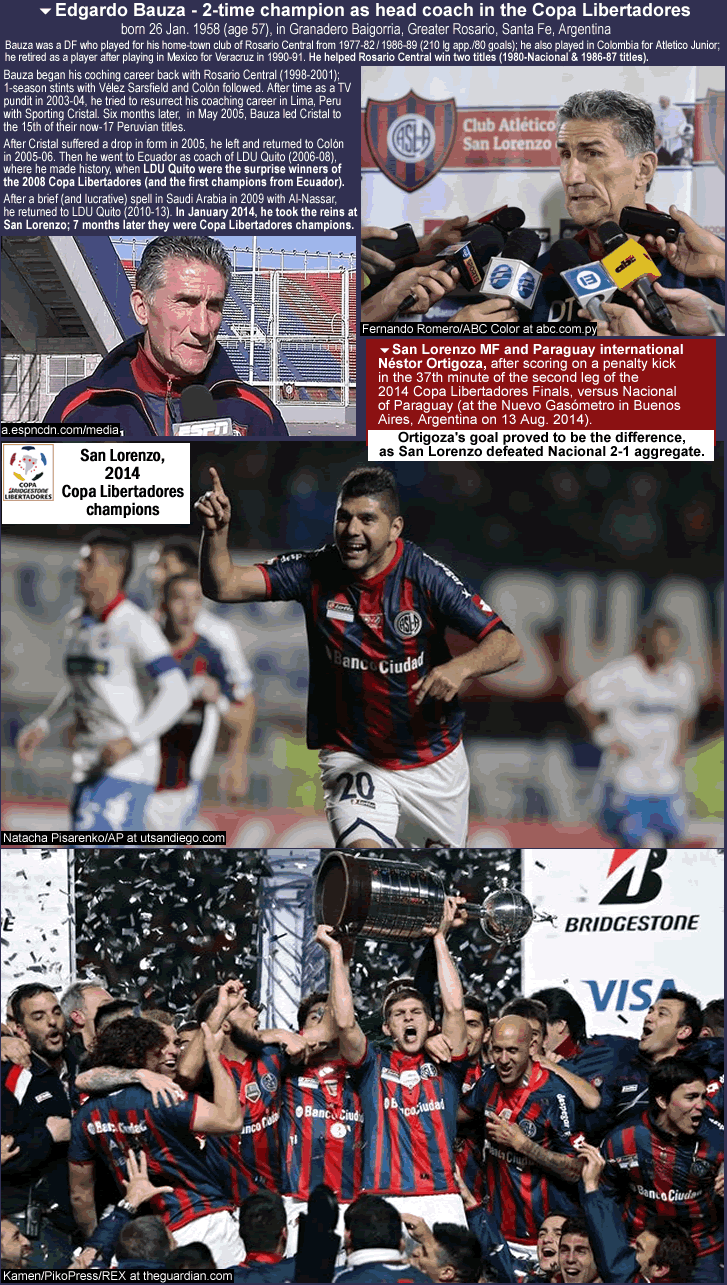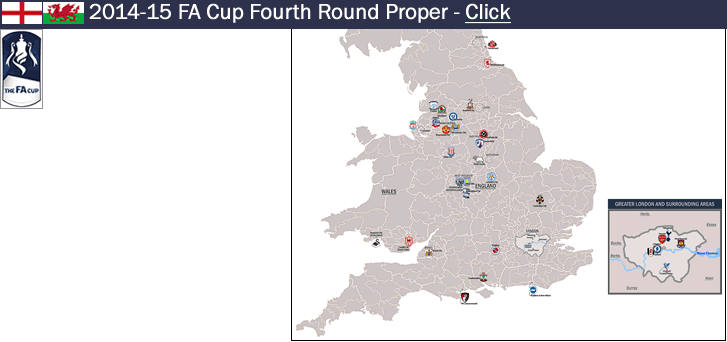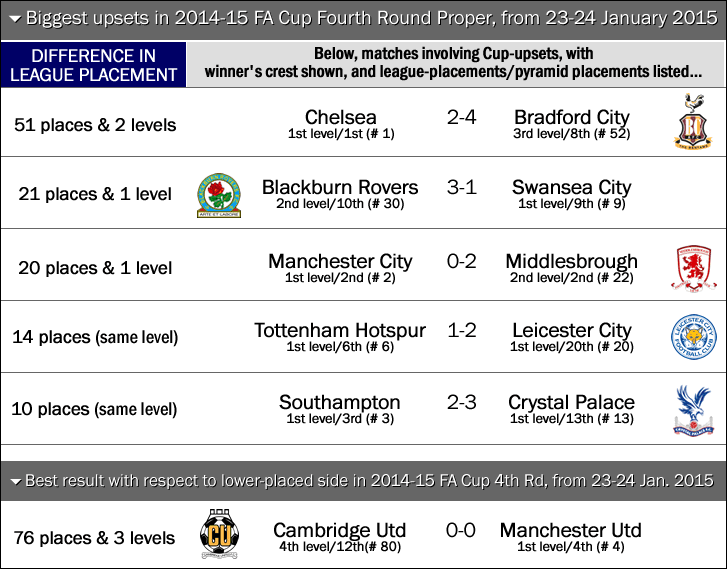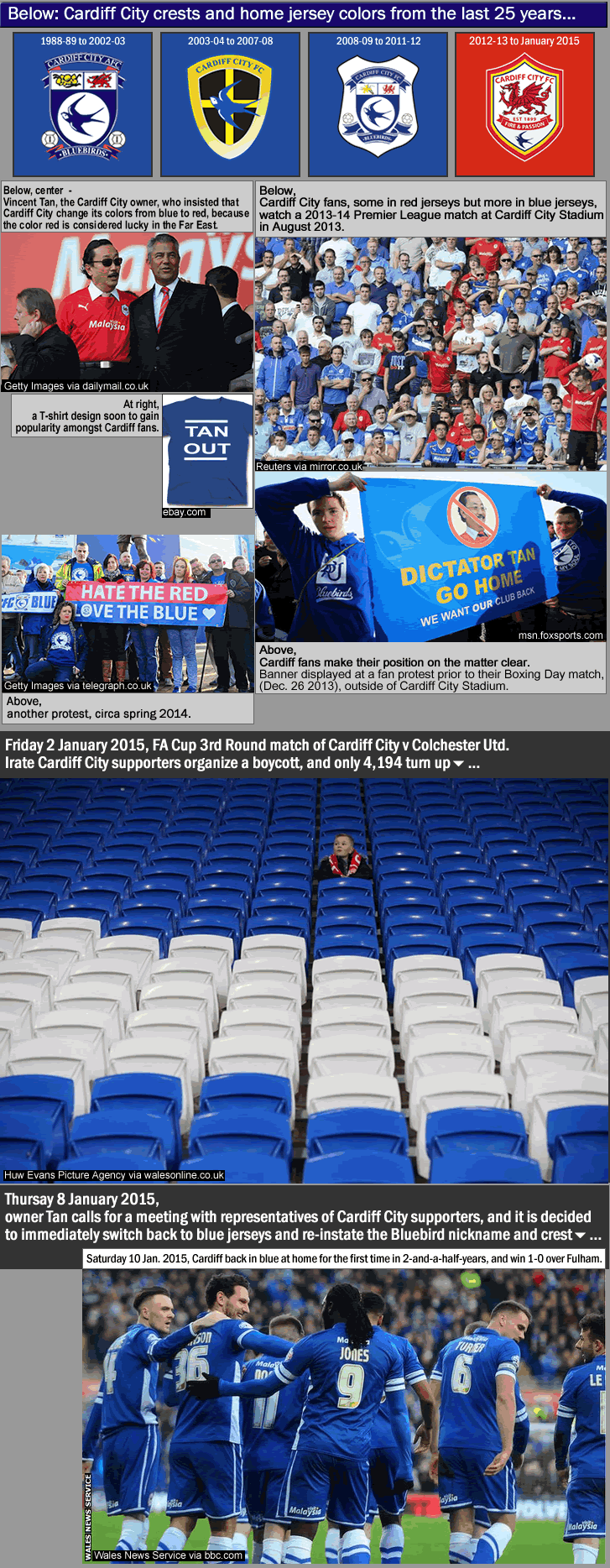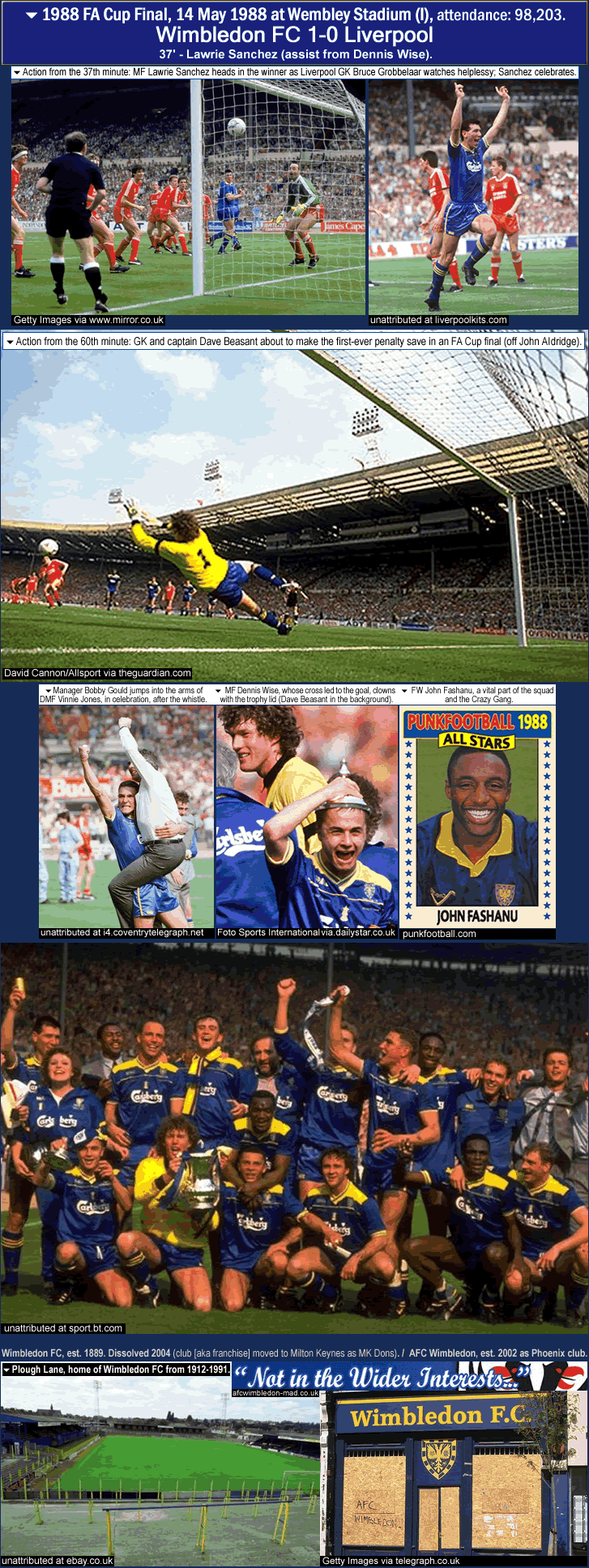
Argentina: location-map for the 30-club Primera División of 2015, following the 10-team promotion of December 2014
…
…
2014 – Torneo de Transición champions, Racing Club de Avellaneda
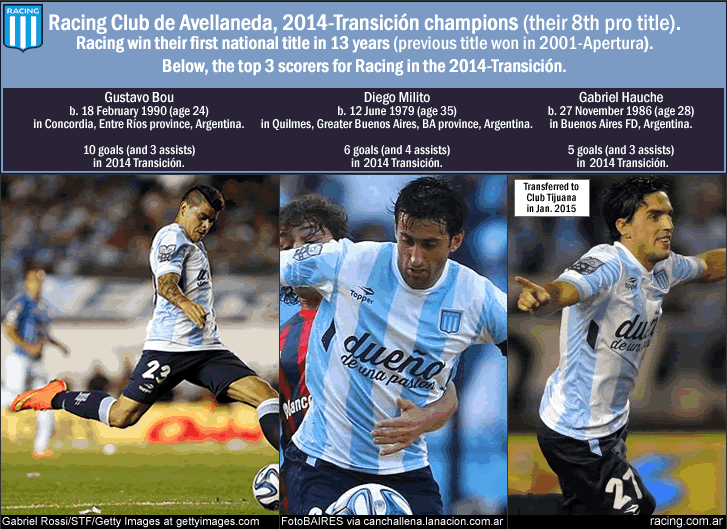
Photo credits above -
Gustavo Bou, photo by Gabriel Rossi/STF/Getty Images at gettyimages.com.
Diego Milito, photo by FotoBAIRES via canchallena.lanacion.com.ar/diego-milito-recibio-el-afecto-del-cilindro-tras-una-decada.
Gabriel Hauche, photo by racing.com.ar.
…
Introduction: the Buenos Aires-centric nature of Argentin’s Primera División…
The Buenos Aires-centric nature of the Argentine top flight has existed from the very start of football in Argentina, and is partly attributable to the lack of decent transportation infrastructure out to the hinterlands, back in the very late 1800s and early 1900s. In fact, in the early days of amateur league football (1891; 1893-1930), and in the first eight seasons of pro league football in Argentina (1931 to 1938), only teams from Buenos Aires Federal District, Greater Buenos Aires, and the nearby city of La Plata were allowed to play in the first division (the distance from Buenos Aires city center to La Plata is around 53 km or 33 mi). The Buenos Aires-centric nature of Argentina’s first division also simply reflects the huge influence that the giant and sprawling city and metropolitan-area of Buenos Aires has always had on the country itself. Simple demographics point to this, with, currently, over one-quarter (around 28%) of Argentina’s population living within Greater Buenos Aires. Argentina has a population of around 44.6 million {2014 estimate}, and Greater Buenos Aires has a population of around 12.8 million {2010 census}. There is another reason why most of the big and successful clubs in Argentina come from the Buenos Aires region, and that is how the AFA (Asociación del Fútbol Argentino) rules for club representation in 1931 gave the “Big Five” clubs (three from Buenos Aires FD and two from the adjacent municipality of Avellaneda) triple the representation of other clubs (see two paragraphs below).
The Argentine first division was established at a rather early time period – 1891 and 1893 – and the 1893-to-1930 iteration was in fact the first functioning football league established outside of Great Britain (the Argentine first division turned professional in 1931). Once the clubs and the game itself got established, that Buenos Aires-centric nature became embedded. The Buenos-Aires/La-Plata-clubs-only rule existed all through the amateur era (1891; 1893-1930) and for the first 8 pro seasons (1931-38). Then in 1939, two clubs from Argentina’s third-largest city Rosario – Newell’s Old Boys and Rosario Central – from the somewhat nearby province of Santa Fe, were allowed to join the first division (distance from Rosario to Buenos Aires by road is around 280 km or around 174 mi). And then 37 years later, in 1966, one year before the first division structure changed in 1967, another club from Santa Fe province (Colón, from the city of Santa Fe), was allowed to join the first division. But clubs from Córdoba – the second-largest city in Argentina – as well as clubs from all the rest of Argentina outside Buenos Aires province and Santa Fe province – were still excluded from the top flight. The following year – 1967 – the Metropolitano/Nacional league system was introduced, and clubs from the areas outside of Buenos Aires and Santa Fe provinces were finally allowed to compete for the chance to win promotion to the first division (see four paragraphs below for a brief synopsis of the 1st division formats in Argentina).
The Big Five – and how AFA rules effectively institutionalized the dominance of Greater Buenos Aires-based clubs…
From the start of the re-organization of Argentine football in 1931 all the way until 1966, only 5 clubs won the title – Boca Juniors, Independiente, Racing, River Plate, and San Lorenzo – aka the Big Five. This was partly the result of rules the Argentine Footbol Association instituted in 1931, when football became professional at the top level and when that governing body took control of football in the country. Here is an excerpt from the The Big Five of Argentine football at en.wikipedia.org…{excerpt}…”The term [the Big Five] was coined in the 1930 decade, with the establishment of the Argentine Football Association (AFA). The AFA arranged a system of proportional representation for the involved sport clubs: the vote of the clubs with either 15,000 members and at least 20 years playing the tournament and 2 or more championships would weight threefold, the vote of clubs with 20 years playing the tournament and 10,000 to 15,000 members or 1 championship would weight twofold, and the vote of the others would have the standard value. Boca, Independiente, Racing, River and San Lorenzo were the only five clubs who qualified for the threefold vote. The five teams would have a leading role in Argentine football since then, and during the first 36 years of the AFA (1931 to 1966) no team outside the five got the championship. The first one to do so was Estudiantes de la Plata, in 1967.”…{end of excerpt at http://en.wikipedia.org/wiki/The_Big_Five_of_Argentine_football). To this day the Big Five are among the most successful clubs in Argentina, with only Vélez Sarsfield having won more professional titles (titles won since 1931) than some of the Big 5 clubs (see Argentine pro tiles list on the map page at the top of this post, or see it here {at es.wikipedia.org/Primera División de Argentina/Resumen estadístico}).

Photos of Big Five jerseys – River Plate, unattributed at futboleros.co. Boca Juniors, unattributed at footyheadlines.com/2014/05/nike-boca-juniors-14-15-home-kit-leaked. San Lorenzo, sportec.com.ar/shop/san-lorenzo-de-almagro-topper-2014-home-jersey. Independiente, tienda.clubaindependiente.com/camiseta-independiente-titular-2014-2015. Racing Club, futbol10shop.com/racing-club-home-jersey-2014.
You can see the Buenos Aires-centric nature of the Argentine top flight to this day …
Greater Buenos Aires-based clubs almost always account for more than half of the first division teams to this day. In 2014 it was 60% (12 Greater BA-based clubs). [Note: and in 2015, it will be 53% (with 16 Greater BA-based clubs/see 10-13 paragraphs below).] Here is the breakdown-by-provinces of the most recent season of Primera División… In the (September-to-December) 2014-Transición season, only 4 of the 23 provinces of Argentina had first division representation. And 15 of the 20 clubs in the Primera División in the 2014-Transición were from Greater Buenos Aires/Buenos Aires province. A whopping 12 of the 20 clubs in the Primera División were from Greater Buenos Aires: 4 clubs from Buenos Aires Federal District (Boca Juniors, River Plate, San Lorenzo, Vélez Sarsfield), plus 8 more clubs from Greater Buenos Aires (Arsenal, Banfield, Independiente, Lanús, Quilmes, Racing, Tigre, and top-flight newcomers in 2014 Defensa y Justicia), with 3 more clubs from other parts of the rather large Buenos Aires Province [BA province is slightly larger than the US state of Arizona and is the largest province in Argentina], two of those being from the near-to-Buenos Aires city of La Plata (Estudiantes and Gimnasia LP), the other being the sole outlier in far south Buenos Aires province in Bahia Blanca (Club Olimpo, who will be playing in their 10th season of top flight football in 2015). The rest of the 2014-Transición field was comprised of the following 5 clubs… 3 clubs from Santa Fe province, with 2 from the city of Rosario (Newell’s Old Boys and Rosario Central), and 1 from the city of Rafaela (Atlético de Rafaela). 1 club from the city of Córdoba in Córdoba province (Belgrano). 1 club from the city of Mendoza in Mendoza province (Godoy Cruz).
…
History of tournament formats in First Division football in Argentina, 1891-2015…
1891; 1893-1966: round-robin-style tournament for national title, initially contested only by clubs from Buenos Aires/BA province; later Rosario clubs (in 1939) and Santa Fe clubs (in 1966) allowed.
[Amateur from 1891; 1893-1930; Professional from 1931-on. Only 5 clubs won titles from 1930-66 (River Plate, Boca Juniors, Independiente, Racing, San Lorenzo: the Big Five).]
[1931: First Division becomes professional.]
1967-85: national title awarded twice per season, with the Metropolitano contested only by clubs from old tournament / and with the Nacional open to all [Metropolitano season played first until 1980-81].
1985-1991: European-style tournament, with season running from August to May, clubs playing each other home & away, and one title awarded each May.
1991-2012: return to two single-round tournaments as in 1967-85, but now both tournaments open to all, with Apertura in August-December and with Clausura in January-May.
2012-14: a Super Final instituted [but for only two seasons, it turned out], contested between the 2 single-round winners; the 2 single-round tournaments renamed Inicial and Final, but with the Inicial & Final titles still counting as national titles, and with the Super Final title being a title of its own but not a national title [akin to the Community Shield title in England]; however, AFA never rescinded Vélez Sarsfield’s 2012-13 [Superfinal] title, so Vélez Sarsfield, bizarrely, basically got an extra national title, whereas the Superfinal winner for 2013-14, River Plate, were not allowed to count their Superfinal title as a national title (seriously).
2014-Transición: the August-December tournament has no teams relegated, as league transitions to an expanded tournament.
2015: First Division (Primera Division) expanded from 20 teams to 30 teams via mass-10-team-promotion of Second Division clubs; each team plays each other once, with the 30th game being a clásico (derby/historic rivalry) match; season to go from February 2015 to December 2015, with a halfway-break break in June.
…
2015: Argentina’s AFA institutes a 10-team expansion of the Primera División (going from 20 teams to 30 teams)…
-From the Turkish Press site, from 30 April 2014, by Charles Newbery, Argentina football league expansion seen as political (turkishpress.com).
-From Caught Offside.com, from 10 Nov. 2014, by Charles Price, Argentina’s 30-Team Primera Division Disaster (caughtoffside.com).
-From the Daily Mail, from 18 Nov. 2014 , by Reuters, Argentine FA set to go ahead with 30-team top flight (dailymail.co.uk/wires).
Five-and-a-half years ago, in mid-2009, the Argentine Primera División’s television rights were bought by the national government, and all games are now shown free on public TV on the country’s state TV network {see this article from July 2010 from the Soccer Politics blog, by Jeffrey Richey, Argentine Soccer Politics: Fútbol Para Todos, Continued}. This was done as a blatant attempt to grab votes. Since the 2009-10 season, Primera División games are broadcast free (and are streamed for free online/see link in next sentence), and the government uses the platform to curry favor with the populace (filling much of the advertising space with puff-piece-propaganda for the political party in charge). {Free streaming of Argentina Premiera División at futbolparatodos.com.ar}. The arrangement is wildly popular, but it hasn’t actually resulted in much more favorable opinions towards the party-in-charge (the Front for Victory party, a Peronist/center-left coalition headed by President Cristina Fernández de Kirchner). Much of the football media in Argentina is dead set against them, especially the more right-wing media outlets, and most especially as with respect to Grupo Clarin, who lost the broadcasting rights and then sued the government (unsuccessfully), claiming the rights to broadcast the Primera División were basically stolen from them. As it says in the article by Jeffrey Richey in the link at the top of this paragraph, {excerpt}…”Certain sectors of the Argentine media have had a central role in rallying public opinion against the Kirchners. In the immediate wake of Fútbol Para Todos, political criticism of the Fernández administration in the various arms of Grupo Clarín media reached a crescendo from which it has yet to descend.”
With a Presidential election coming up in October 2015, and with the sitting government headed by President Cristina Fernández de Kirchner facing abysmal poll numbers (like 20%-favorable poll numbers), the party-in-charge is again trying leverage political gain via first-division football. This time they hope to gain more support in the hinterlands by expanding the league 50 percent – from 20 teams to an unheard-of 30 teams.
There are many who feel that the 10-team expansion of the first division smacks of those in power in Argentina seeking cynical short-term gain at the expense of the long-term viability of the professional game in Argentina, where clubs have seen their ability to maintain high-caliber and stable squads eroded by the continued rise of club football in Europe. To put it another way, as soon as a young Argentine footballer of exceptional skill gets established, he is sold off to a money-laden European club. And watering down the talent-level with the inclusion of 10 second-division-caliber clubs will only further diminish the standard of play in the Argentine top flight. At the NonLeagueMatters.co.uk forum, commenter Edgeley says…{excerpt}…”The general view of most fans in Argentina is that the idea of a 30 club division is madness but it is happening and it looks like once it is established then it will not be easy to undo it in a hurry”…(from nonleaguematters.co.uk/forum/post=600625 [Argentine First Division expansion, ca. June 2014]).
In April of 2014, the long-serving head of the Argentina FA Julio Grondona had initiated the expansion plan…
Grondona’s power (amid all the allegations of corruption over the years) was such that few had the ability to effectively produce an opposition to the radical expansion. But once the 82-year-old Grondona passed away in July 2014, opposition to the the 10-team expansion began to coalesce. Of course the big clubs including the Big Five oppose it. But some of the less established first division clubs are set against it – if only because their share of broadcast revenue will be diminished once the pie is cut into 30 instead of 20.
The most logical aspect of the 30-team first division is the switch to a single August-to-May season (like with European leagues). (The Argentine Primera División had had a two-title/dual-tournament season-format from 1991-92 to 2013-14.)
The whole 10-team expansion plan had been constantly changing all through October, November, and December 2014, but it now looks like the plan is set. The season for 2015 will be a unique one-time setup and will go from February to December 2015, with a mid-June break. Two clubs will be relegated in December 2015 (with two clubs being promoted up from the 2nd division at the same time). For the 2015 season, each team will play each other team once (29 games), and a clásico (derby/historic rivalry) will account for the match-ups which will be the 30th game. For example, Boca Juniors will play River Plate for their 30th game. Some other 30th games are: Banfield v. Lanús, Estudiantes v. Gimnasia (LP), and Rosario Central v. Newell’s Old Boys. Those are all very real clásicos. But because so many of these clubs don’t have a convenient rival to play, there will be some pretty fictitious “clásicos” on display, like Arsenal v. Defensa y Justicia or Tigre v. Vélez Sarsfield. As pedrocoates says in the following article from 17th December 2014 at Golazo Argentina blog, “Where this gets complicated is that AFA have had to create a number of clásicos that in fact have little or no history – Vélez against Tigre is one such fabricated clásico. This issue highlights the stupidity of the new format given that all 30 teams will in fact have different fixtures and an away match at River or Racing is considerably more difficult than say, a visit to Crucero del Norte.” {excerpt from AFA release 2015 30-team Primera fixtures (golazoargentino.com)}.
From the AFA site, here is the fixtures list, Fixture de Primera División [2015] (afa.org.ar).
From the Buenos Aires Herald, from 13 November 2014, Top clubs, Argentine FA remain in conflict over structure of new 30-team top division (buenosairesherald.com).}
From the Buenos Aires Herald, from 28 November 2014, by Eric Weill/Sports World, ‘What is the AFA for?’ (buenosairesherald.com)
The 30-team league will remain in place for two seasons – in 2015 (the aforementioned full 10-month/ 30-match season), with two teams relegated and two promoted up from the second division in December 2015. So there will still be 30 teams in the 1st division for the next tournament – in the first-half of 2016 (a temporary 5-month/14-match half-season with the 1st division split into 2 groups of 15), with three teams relegated and one team promoted following that half-season in 2016. Then, after a full year/quasi-Apertura-and-Clausura format starting in mid-2016 and ending in June 2017, four clubs will be relegated and two promoted. Thus the plan is not to actually end up with a 30-team league down the road, but whittle away the 30-team field via a staggered relegation/promotion schedule (again, with less teams promoted up being than being relegated down each calender year), until the first-division field is down to 24 clubs. Or maybe down to 22 clubs. Or maybe down to 20 clubs once again. That final first-division-quantity-of-teams is still yet to be determined, and there is a high probability that there will be still more changes to the format. (In fact, a faction is lobbying for there to be no relegation once again in 2015, so that there would be a 32-team league come 2016!)
Here, via the Argentine Primera División page at en.wikipedia.org, is the breakdown of the format for the next 5 seasons…
[2015] – From February to December 2015, the league will be contested between thirty teams. Two teams will be relegated to and two teams will be promoted from Primera B Nacional.
[2016] – In the first half of 2016, the league will be contested between thirty teams. Three teams will be relegated to and one team will be promoted from Primera B Nacional.
[2016-17] – From August 2016 to June 2017, the league will be contested between twenty-eight teams. Four teams will be relegated to and two teams will be promoted from Primera B Nacional.
[2017-18] – From August 2017 to June 2018, the league will be contested between twenty-six teams. Four teams will be relegated to and two teams will be promoted from Primera B Nacional.
[2018-19] – From August 2018 to June 2019, the league will be contested between twenty-four teams. Four teams will be relegated to and two teams will be promoted from Primera B Nacional.
As the Buenos Aires Herald notes in an editorial from 27 November 2014,…{excerpt}…” Did nobody dare to question Grondona’s judgement even if this form of honouring him is akin to erecting a statue with built-in demolition plans? Or is there a hidden political agenda with the idea of creating the illusion of a more federal soccer for the election year of 2015, even if it is impossible to maintain in the long term?”…{end of excerpt at Passion of multitudes (of clubs) at buenosairesherald.com)}
Locations of the 10 newly-promoted clubs (promoted in December 2014), and the colossal irony that most are actually NOT from the hinterlands…
A couple of these 10 newly-promoted clubs will be coming from the outer provinces, where few if any clubs are ever in the top flight in Argentina. But most of these 10 newly-promoted clubs are actually coming from the traditionally-allowed-in-the-1st-division areas of Buenos Aires province and Santa Fe province.
3 of the 10 newly-promoted clubs are from Buenos Aires Federal District…Nueva Chicago (now with 7 seasons played in the first division [counting 2015], previously in 2006-07), and two perennial first division clubs: Huracán (now with 73 seasons in the first division, previously in 2009-10); and Argentinos Juniors (now with 65 seasons in the first division, previously in 2013-14). Also one newly-promoted club is from Greater Buenos Aires, from just south of Banfield in the far southern suburbs – Temperley (now with 9 seasons in the first division, previously in 1986-87). Also, two clubs, one of whom is making their first division debut in 2015, are from outlying parts of Buenos Aires province – top-flight-newcomers Aldosivi (from Mar del Plata, which is on the Atlantic Ocean and located around 410 km or around 255 miles south-east of Buenos Aires by road); and Sarmiento, from Junín, which is located near the border of Santa Fe province around 267 km or around 166 miles west of Buenos Aires by road (Sarmiento were previously in the 1st division (Nacional) for a 2-season-spell in 1981 and 1982; this [2015] will be their 3rd season in the 1st division). Also, two newly-promoted clubs are both from the city of Santa Fe in Santa Fe province – one is an old first division standby – Colón (now with 36 seasons in the first division, previously in 2013-14); the other club being promoted up from Santa Fe is also with many years as a top flight team – Unión de Santa Fe (now with 30 seasons in the first division, previously in 2012-13).
So that means that just 2 (or maybe 3) of the 10 newly-promoted clubs are actually from the hinterlands (the hinterlands being the areas that weren’t allowed to have clubs in the 1st division before 1967).
[Note: by saying "(or maybe 3)" in the sentence above, I am referring to Aldosivi of Mar del Plata, because it is kind of debatable if the authorities would have ever let in Aldosivi into the pre-1967 era first division, had they been slated for promotion. But they almost certainly would have let in Sarmiento, seeing as how Sarmiento's location in Junín is basically halfway from Buenos Aires to the allowed-in-the-1st-division city of Rosario.] The two newly-promoted clubs that are actually from the hinterlands are the following… San Martín (SJ) (now with 4 seasons in the first division, previously in 212-13), from the city of San Juan (metro-area population of around 453,000) in the arid San Juan province in the far west of the country near the border with Chile. And first-division-newcomers Crucero del Norte, who are a very new club (est. 1989), from Garupá, a suburb of Posadas (metro-area population of around 334,000), which is in the sub-tropical Misiones province in the far north-east of the country near the borders with Paraguay and Brazil.
That seems like a small yield for all the effort of the 10-team-promotion…whose aim was to put more clubs from the hinterlands into the top tier. And it is indicative of the reason the late Julio Grondona really wanted to expand the first division even more – to 38 teams…because allowing “just” 10 more teams into the top flight would probably end up promoting many clubs that were not from the hinterlands. And that is exactly what has happened.
…
The map page
The map page features a basic location-map-with-inset-map (inset-map for Greater Buenos Aires). The Argentina National Professional Titles list (1931 to 2014-Transicion) is at the upper-right-hand corner of the map page. At the right-hand-side of the map page I have also included a chart that shows three items for each of the 30 clubs: 1). national pro titles (and year of last title), 2). seasons in the 1st division, and 3). each club’s stadium capacity (sorry I could not include last season’s average attendance figures, but unfortunately for several reasons including corruption and tax-dodging, the reporting of attendance figures in Argentine football is a thing that simply does not exist). On the map and on the Greater Buenos Aires inset map, I have listed the estimated metropolitan-area (aka urban area) populations of each city which has 1st division representation in 2015. I have also listed the estimated populations of all barrios (neighborhoods) of Buenos Aires Federal District which have 1st division representation in 2015. Those populations are found in gray boxes adjacent to each club’s crest (sources can be found immediately below). I have also shown on the map the 8 largest cities in Argentina (all cities in the country with a metro-area population above 500,000). (The 8 largest cities in Argentina, in order of metro-area population, are: Buenos Aires, Córdoba, Rosario, Mendoza, Tucumán, La Plata, Mar del Plata, Salta.)
Sources for map and titles chart:
-Source for city metro populations from Anexo:Aglomerados urbanos de Argentina;
barrio populations found at Barrios and Communes of Buenos Aires; cities within Greater Buenos Aires, with populations found at each page via 2015 Argentine Primera División/Club information.
-Seasons played in Argentine top flight, by club: Primera División de Argentina/Equipos participantes (es.wikipedia.org); LIST OF ARGENTINIAN CLUBS AND DIVISIONAL MOVEMENTS (Professional Era 1931-2007/08) (rsssf.com).
-Titles (professional Argentine titles): http://es.wikipedia.org/wiki/Primera_Divisi%C3%B3n_de_Argentina#Resumen_estad.C3.ADstico_2.
-Stadium capacities: 2014 Argentine Primera División; 2014–15 Primera B Nacional (en.wikipedia.org).
-Attendance figures (which I ended up not listing due to the high probability that they were not very accurate): very few (if any) media outlets report Argentina Primera División attendances. The following link (World Football.net) reports crowd estimates for Primera División only, worldfootball.net/attendance/arg-primera-division-2014-2015-torneo-inicial/1/.
___
For blank maps of Argentina and of Greater Buenos Aires, thanks to NordNordWest at File:Argentina Greater Buenos Aires location map.svg; and at File:Argentina location map.svg (en.wikipedia.org).
Thanks to Sam Kelly and company at the Hand of Pod podcast (the only English-speaking podcast on Argentine football), for information and for updates on the 10-team 1st division expansion, https://handofpod.wordpress.com.
Thanks to the contributors at en. and es.wikipedia.org, Argentine Primera División; Primera B Nacional.


